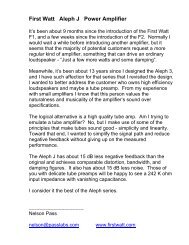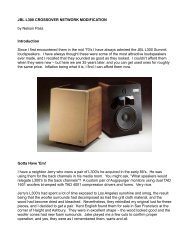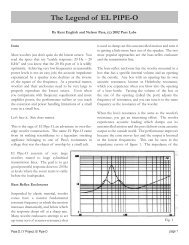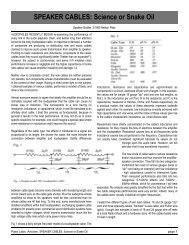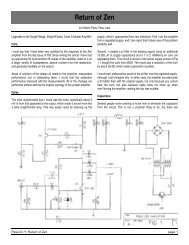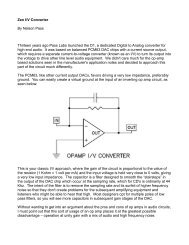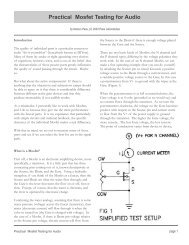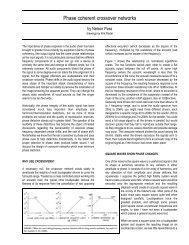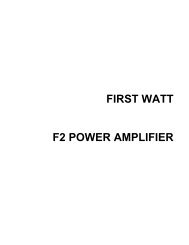PLH AMPLIFIER - First Watt
PLH AMPLIFIER - First Watt
PLH AMPLIFIER - First Watt
- No tags were found...
Create successful ePaper yourself
Turn your PDF publications into a flip-book with our unique Google optimized e-Paper software.
The <strong>PLH</strong> AmplifierBy Nelson PassIntroduction: The JLH AmplifierIn 1969 John Linsley-Hood wrote in Wireless World:During the past few years a number of excellent designs have been published fordomestic audio amplifiers. However, some of these designs are now renderedobsolescent by changes in the availability of components, and others are intended toprovide levels of power output which are in excess of the requirements of a normal livingroom. Also, most designs have tended to be rather complex.In the circumstances it seemed worth while to consider just how simple a design could bemade which would give adequate output power together with a standard of performancewhich was beyond reproach, and this study has resulted in the present design.He then described a Class A power amplifier using three gain stages of Bipolar transistors in atopology which continues to be admired for its elegant simplicity and sound quality.The centerpiece of this design is the middle stage, an NPN transistor used as a phase splitter,simultaneously driving the positive half of the output stage and the negative half with symmetricsignals of opposite phase.Figure 1 shows a simplified version of the JLH topology. Signal input appears at the Base ofQ1, and is amplified and inverted to drive the Base of Q2. Q2 acts as a gain device and also asignal splitter, driving both Q3 and Q4 simultaneously, but out of phase with each other. Q3 andQ4 form the output transistors, Q3 operating as a Common Emitter gain device, contributingcurrent and voltage gain, and Q4 operating as a Common Collector device contributing onlycurrent gain. The resistors provide bias for the system, and R1 and R2 feed the output of theamplifier in a loop back to the emitter of Q1.Q2 is the heart of the design, and in my opinion, it is the elegant economy with which it performsthe complementary gain to drive the output devices that gives the circuit its classic beauty.
The JLH was designed at a time when “the tube era was in decline” and the new generation ofdesigners were pulling out all the stops to create big science amplifiers - pure voltage sourceswith high power and infinitesimal distortion – complex circuits with lots of feedback.36 years and a little progress later, we can perhaps appreciate the simple charm of the JLHtopology as an exercise in minimalism, but if you haven’t listened to one, you might be verysurprised by the quality of sound, which is extraordinarily good within it’s power limitations. Ifyou have efficient speakers and you like to listen to two-channel sound at reasonable levels, theJLH is still in the top rank.The amplifier has reasonable specifications; nothing special that isn’t wildly exceeded by a $3chip, but it produces real music. Its flaws are not irritating and it does a wonderful job wringingmore music out of modern recordings and even MP3’s. I can’t think of another transistor designfrom that era that works as well.Figure 2 shows the circuit rendered more completely, but for more extensive documentation onthe versions of the JLH amplifier, I recommend The Class A Amplifier Site:www.tcaas.btinternet.co.ukIn Figure 2 additional details of setting up the DC bias for each device are shown, wherecapacitors are used to separate DC values from AC values. C1 separates feedback from biascurrent. C2 separates input signal from input DC bias voltage and C3 blocks the output DC ofthe amplifier from the load. C4 removes supply noise from the voltage powering the front end ofthe amplifier, and C5 forms a “bootstrap” circuit, making resistors R5 and R6 behave more like aconstant current source at audio frequencies.The original JLH amplifier has approximately 55 dB of open loop gain divided into 22 dB ofamplifier gain and about 33 dB of feedback. As detailed in the original article, it delivered 10watts at approximately .1% harmonic distortion or less.
The amplifier’s popular longevity speaks volumes about the quality of its sound, and this isunderstandable given its simplicity coupled with excellent measured performance. It has aparticularly tube-like quality compared to the more complex solid-state designs of the era andsince.The distortion is largely 2 nd harmonic, and is closely proportional to the output voltage. Thismeans that .01% distortion at .1 watts becomes 1% at 10 watts, and you can draw a prettystraight line between the two points on a logarithmic graph. Such a curve is characteristic of asingle-ended output topology, and there have been arguments regarding whether or not theoutput stage is single-ended Class A, push-pull Class A or a mixture of both. We will be havingsome fun with that later.One flaw in the original JLH design was that its bias current, that idling current which flowsthrough the parts of the circuit, had some dependency on the power supply voltage, resulting inaltered performance for different AC line voltages. Power supply regulation solves this problemneatly, but there were other ways this was addressed in later versions of the circuit.Newer JLH CircuitsJohn Linsley-Hood published an update to the amplifier in 1996 that addressed bias stabilityissues, parts substitutions, and provided a version that had a direct-coupled output, eliminatingthe output capacitor. At the same time, it was in many ways the same amplifier, the measuredperformance being very similar.The JLH circuit continues to be interesting to the audiophile community and has been thesubject of several updates. Figures 3 and 4 show simplified schematics of later generations ofJLH amplifiers.
Figure 3 shows a simplified schematic of the 1996 version published by John Linsley-Hood thatfixes the bias stability issue with the addition of Z1 and the Q5 portion of the circuit. This versionalso direct coupled the output of the amplifier, using dual supply rails.In 2000 someone else produced the circuit seen in Figure 4, where constant current sources areused to bias the first two gain stages, giving good power supply rejection to the circuit. Thisversion also doubled up on the number of output devices. You will notice that Fig 1 – 4 havetheir feedback loop addressing the Emitter of the feedback transistor. Nowadays they havegotten fancy and call it “current feedback”.Just for your entertainment, I cobbled together the circuit of Figure 5 shows an example with adifferential input. An obvious variation, but I haven’t seen it used. You can drive this input stagewith a balanced signal by lifting C1 from ground and driving it as a negative input. At 100 ohmseach, R6 and R7 will give this input about the same open loop gain as the original inputtransistor with the 220 ohms degeneration of the original feedback impedance.
I recently measured the performance of a working copy of the circuit of Figure 4. It had 17.5 voltsupply rails and was biased at about 2 amps per channel. The open loop gain is also about 55dB into 8 ohms, and its measured performance is comparable to the original circuit.Figure 6 shows the distortion versus output power. The bandwidth of the amplifier is –3 dB at100 KHz, the damping factor is about 35, and the distortion versus frequency is fairly flat, risingslightly at 20 KHz.The <strong>PLH</strong> AmplifierOne of the issues that arise from adding gain stages to amplifiers is that while they increase theopen loop gain and allow more feedback correction, they themselves are the source ofadditional distortion. While the extra feedback can lower the distortion numbers, usually theadditional circuitry is reflected in a more complex distortion character having higher orderharmonics and inter-modulation components. These are generally agreed to be less musicalsounding.Michael Cunningham wrote, “Novelists must usually decide what degree of slavish accuracywould make their stories more alive, and what degree would make them less.” The amplifierdesigner has a similar problem to solve. It’s not hard to make an amplifier that measures well –it’s comparatively hard to please audiophiles.My own approach is to make the signal path as simple as possible, work to lower the distortionof that basic circuit before feedback is applied, and then apply minimal (or no) feedback, largelyin agreement with the comments in Linsley-Hood’s original article. The result is not always thebest objective measurements, but the sound is often interesting.The 3-stage topology of the JLH amplifier routinely uses simple Class A operation and about 33DB negative feedback to achieve this performance, and this lured me to consider what kind ofamplifier I could achieve with an even simpler circuit and less feedback. The output stage andthe intermediate phase splitter cannot be dispensed with and still resemble a JLH, but you cancertainly remove the input transistor.
By thumbnail calculation, the input transistor of the JLH contributes about 27 dB of voltage gain.Remove it and the open loop gain of the amplifier drops into the region of about 28 dB. If wescale back the gain of the amplifier from 22 dB to 18 dB, we end up with about 10 dB offeedback – a very minimal amount. Unfortunately only 10 dB of feedback means that theoriginal amplifier will likely deliver something more like 1.5% distortion at 10 watts. Since such afigure is better than that seen on many single-ended Class A tube amplifiers (SET), this mightbe an acceptable amplifier. Actually, since the input transistor is no longer contributing to thedistortion figure, we would expect the performance to be better than that, and maybe that’s thepoint.With that in mind, I stripped down the JLH to the simpler Mosfet topology shown in Figure 7, and(ahem) added my initial to the name.I chose Mosfets for their high input impedance and because they really deliver their most linearoperation in Class A mode. Since the JLH performs two phase inversions in the signal path,removing the input leaves the amplifier phase inverting, and we will be labeling the output nodeas “minus” and the output ground as “plus”.The feedback path of R1 and R2 now addresses a “virtual ground” at the Gate of Q1. Q1 isbiased by a current source I1, and drives the Gates of Q2 and Q3 simultaneously with voltage ofopposite phase.As a concept, you can get about 35 dB open loop gain from this circuit with the Mosfets weintend to use. You would only see it at lower frequencies however, because the Gatecapacitance of the Mosfets will come into play at the higher audio frequencies.To give a more uniform open loop gain to this circuit across the audio band, and a moreinteresting comparison to the original circuit, we will be choosing our values to be more similarto the original JLH without the input transistor, which means that for the circuit of Figure 7, wewould be adding .47 ohm Source resistors to Q2 and Q3, and this will give us about 26 dB openloop gain.
Like the original JLH, this circuit operates between a positive voltage and ground, so you willneed input and output coupling capacitors. There is no reason that it can’t be made directcoupledusing dual supplies, but we will save that for another time.Figure 8 shows the actual circuit. As with the simplified circuit, Q1 is the input transistor and thefeedback is accomplished through R1 and R2. The Source of Q1 follows the Gate input signaland drives the transistor Q3 in Common Source mode (voltage and current gain). The Drain ofQ1 delivers an inverted and amplified version of the input signal to drive transistor Q3 inCommon Drain mode (current gain).The idealized current source I1 and R* of the simplified circuit is replaced by the network of P2,R4, and C2. C2 creates a “bootstrap” connection to the output that makes P2 look like aconstant current source in parallel with R*, approximately the resistance between the wiper andthe counter-clockwise connection of P2. P1, R6 and C5 form a filter to take out power supplynoise, and adjusting P1 will set the bias current of the amplifier.P2 will be used to set the relative gain contribution of the upper transistor Q3 versus the lowertransistor Q2, but does not affect the bias current or output DC value.Most of the resistors are ¼ watt types, but I recommend a 3 watt value for R4 and R8 and R9.The capacitors are all rated at 50 volts. None of the values needs tight tolerance. P2 is bestchosen as higher wattage type. You can get by with 2 watts, but 5 watts is preferred.I have shown nominal voltages on the schematic as guides. The circuit will work with supplyvoltages from 35 to 45 volts without modification using P1 and P3 potentiometers to adjust thebias current and output DC. This particular amplifier is biased at 2 amps, and the output voltageis set at 20 volts, or one-half of the 40 volt supply value.
The Mosfets used are fairly arbitrary, and in general you can substitute similar types. Sincevirtually all the power Mosfets are rated at least 40 volts, you are left wide latitude of choices ofvertical types. Lateral Mosfets would also work with adjusted resistor values. Remember thatall Mosfets are static sensitive. It is not necessary to match the Q2 and Q3. If you send me abag of high power Jfets, I’ll supply a schematic that will work with them, too.You will need a power supply that happily sources 35 to 45 volts at 2 amps per channel. Aregulated supply is most ideal, as the bias will vary in rough proportionality to supply voltage,although we built four units without a regulated supply and they work fine. The heat sinksshould be able to dissipate about 70-90 watts per channel with a rise of about 25 degrees C.You can find examples sprinkled about at www.passdiy.com and elsewhere.This summer, Chris and Matt Williams helped me to build the amplifiers and they all worked themore or less the same. Lucky boys, they got away with two of them. These were made frommachined plates of aluminum, bolted together, with heat sinks made from square aluminumtubing and all of it anodized black. The wiring was all point-to-point on an output stage PCboard. Here’s a picture:PHOTO 1 REAR VIEW OF FINISHED <strong>AMPLIFIER</strong>
We used a transformer with a 35 volt secondary rectified into a 30,000 uF capacitor. We filteredthat supply voltage through a 0.5 ohm @ 25 watt resistor to another 30,000 uF capacitor whichreduced the ripple noise by about 20 dB. This powered both channels.Remember to use good grounding – a star ground at the (-) terminal of the second capacitor is agood idea, and keep the input and grounding leads away from the power supply components, oryou will pick up noise. The chassis should always be Earth grounded to the AC power plug, andthe circuit ground was connected to chassis through a 5 amp power thermistor.AdjustmentAt a minimum, adjustment of the amplifier requires a DC voltmeter. I recommend the use of aVariac to slowly turn on the AC power for your initial check out. Before you apply power to theamplifier, set the value of P1 to its maximum resistance, which should set the bias at a minimumcurrent. Set P2 and P3 at their midpoints.I recommend firing up (unfortunate phrase, that) one channel at a time, with the other channeldisconnected from the supply rail. It’s a good idea to put a 3 amp fast blow fuse in series withthe positive rail of each channel, and to keep some spare fuses handy.When power is applied, the output of the amplifier, the voltage across the Source resistors R8and R9 should be less than 1 volt. The output DC voltage, as seen on the Drain of Q2 shouldbe somewhere around 20 volts.If you can bring the supply rail up to 40 volts without having the bias go above 1 volt, then adjustP3 to put the output voltage at about one-half the supply voltage (20 volts with a 40 volt rail).Now slowly decrease the value of P1 until the Source resistor voltage approaches 1 volt.As the channel warms up, adjust P1 and P3 in small steps so that the output is at 20 volts andthe voltage one of the Source resistors 1 volt. Watch the output voltage and current draw for ahalf hour or so, readjusting as needed as the circuit warms up. The bias will tend to drift up, butthe DC output value will tend to be more constant. At the end of this procedure you should havea stable channel.If you share two channels off a common supply, you will be taking another look at these settingslater because the supply voltage will drop volt or more when both channels are connected.PerformanceThe final adjusted circuit has an open loop gain of about 26 dB, a closed loop gain of 16 dB, anduses about 10 dB of negative feedback. The bandwidth is -3 dB at about 1 Hz and 100 KHz.The (unweighted) noise is about 80 uV. The input impedance is about 14 Kohms, and theoutput impedance is about 3 ohms (a damping factor of 2.5).The upper and lower output devices share the same value of DC current, but as mentionedbefore, this circuit can be adjusted to vary the AC current contributions from each. When thevalues are set equal then the classic push-pull balance is achieved. By adjusting P2, you canshift this balance so that one device takes a larger share of the output.
As you turn P2 clockwise (note the “cw” on the schematic), a greater percentage of currentcomes from the upper device Q3, and as you turn it counter-clockwise, a greater percentagecomes from the lower device Q2. Fully counter-clockwise results in the upper transistor bankfunctioning as a constant current source, with all the gain in the lower bank, operating as apurely single-ended Class A circuit. An 80% clockwise rotation of P2 gives about a 1:1 ratiobetween the devices (as the pot rotates through about 10 hours of a clock, with full clockwise as11 PM, you would set the pot to 9 PM).Linsley-Hood spent some time experimenting with his circuit using mismatched output devicesand noted that if you don’t have equal gain, it is better to place the devices with greater gain onthe bottom of the circuit. I confirmed that this was the case by adjusting the balance betweenthe positive and negative halves of the output stage, measuring and listening to various settings.I spent a great deal of time playing with this balance, trying to reconcile the best curves to thebest sound. At low and mid-band frequencies, setting P2 to a value that gave equal contributionto the output current resulted in the lowest distortion versus output power. By comparison,setting the value so that the lower half delivered 2/3 of the output current gave about twice thedistortion, but it remained more constant over the audio band.This more “single-ended” output stage showed a more pure second harmonic type distortionthan the more “push-pull” output stage, which contained more third and higher harmonics. Thiswas not a completely apples-to-apples comparison, though, as increasing R5 also had the effectof slightly increasing the open loop gain, and thus the amount of negative feedback.I encourage you to try varying P2. Remember that you can confirm the ratio of upper versuslower output current by measuring the AC voltage across the Source resistors R8 and R9, whilerunning a low frequency sine wave into a resistive load at about 5 watts or so.Figure 9 shows the distortion versus power into 8 ohms at 1 KHz, with the lowest curve showingthe 1/1 ratio (push pull operation) and the highest curve showing a 0/1 ratio (P2 fully counterclockwise)where Q3 operates as a constant current source and the circuit is operated as singleendedClass A.
Figure 10 shows the distortion versus frequency at 1 watt, and we see that the differencesbetween the two settings tends to go away at the highest frequencies, where the variations incapacitance of the devices does not tend to cancel. Also, there are some harmonic contentdifferences over the range of settings. The lowest distortion curves have greater content ofhigher order harmonics, which tend to go away as you move toward single-ended operation.Photo 2 shows an example of the harmonic content with the ratio of top/bottom gain of 2/3,which was one of my favorite settings:PHOTO 2 DISTORTION WAVEFORM @ 1 WATT @ 1 KHZI suggest that you mount P2 on the front panel of the amplifier, and listen to it at the variousvalues. Over most of the range, the open loop gain of the amplifier does not alter significantlyuntil you get close to the counter clockwise position (0/1), where it drops off about 5 dB,resulting about 5 dB of negative feedback. At the 1/1 position, the open loop gain is about 26dB, giving about 10 dB of feedback. Note that the differences you will hear are not strictlyfeedback related, but are also a function of push-pull cancellation of distortion.
When the amount of power and heat starts getting big, we often parallel output devices in acircuit in order to share the dissipation. In this case the dissipation is about 40 watts per device,and it is tempting to use another pair of devices in parallel with the originals to take that valuedown to a more reliable 20 watts per device. Figure 11 shows the circuit that does this. Notethat I have increased the values of the Source resistors to 1.0 ohm.Figure 12 shows the performance of this circuit with the 1/1 setting being the lowest curve, the0/1 setting the highest, and a 2/3 ratio shown in the middle. There is somewhat less distortionthan the curves of Figure 9.
Figure 13 has a little bit different story to tell. At 1 watt over the audio band, the 1/1 ratio mightnot be considered the best choice, as the 2/3 value has a more uniform performance.The question often comes up, “How many output devices in parallel is optimal?” The bestanswer often lies in trial and error. I built a version with 4 parallel devices and 2.0 ohm Sourceresistors. After measurement and listening, I decided that 4 pairs were too many.It’s interesting to look at a casual comparison of the results with the original JLH, <strong>PLH</strong> and twoof the Zen amplifiers in the context of simplicity, gain, and feedback applied. All of the amplifiersmake it up to 10 watts before the distortion becomes too complex, and they all decline at lowerwattages with the second harmonic characteristic described earlier. It’s reasonable to pick 1watt and 10 watts into 8 ohms as benchmarks. For the <strong>PLH</strong> example, I used the circuit ofFigure 11 with the 1/1 setting.The greater amount of feedback on some amplifiers helps them to measure better, so we wouldassume that an otherwise equal amplifier would have some proportionality betweenmeasurement and feedback. I was curious about this – If it were true, then how would theseamplifiers measure if they all had the same amount of feedback?I normalized the output impedance and distortion figures to what we would expect if all theamplifiers had 20 dB of feedback and assumed that the difference would be due to feedback:Gain Open Loop Feedback Zout Normalized THD % Normalized THD % Normalized(dB) (dB) (dB) ohms ohms @ 1 <strong>Watt</strong> @ 1 <strong>Watt</strong> @ 10 <strong>Watt</strong> @ 10 <strong>Watt</strong>JLH 22 55 33 0.23 1.03 0.03 0.13 0.12 0.54ZEN 9 23 15 1.00 0.53 0.60 0.32 2.50 1.33ZV4 13 33 20 0.60 0.60 0.06 0.06 0.20 0.20<strong>PLH</strong> 17 27 10 3.00 0.95 0.04 0.01 0.35 0.11
Here we can see some interesting things. <strong>First</strong>, for unknown reasons the normalized outputimpedances of the JLH and <strong>PLH</strong> are about twice that of the Zen amps.Second, we see that the original Zen amp stands out as having the highest distortion. This ispartially explainable by the fact that the other three designs all have some mechanism to cancelsome distortion without negative feedback. In the JLH and <strong>PLH</strong>, the output stages are drivenout of phase by a phase splitter, and in the ZV4 (Zen Variations #4), the P channel input bufferand Aleph current source offer some cancellation.While the distortion numbers for the JLH are better than the <strong>PLH</strong>, is operates at about 23 dBmore negative feedback. Normalizing these numbers to a 20 dB feedback figure, the <strong>PLH</strong>appears at least 4 times more linear. Of the potential explanations, the first is the possibility thatthe more heavily biased Mosfets are more linear the Bipolar devices.Another possibility is that the input device of the JLH, used to create much of the feedback, iscontributing significantly to the distortion. It could be that the data is in error (like that’s neverhappened), or perhaps the calculation assumption that the distortion would be inverselyproportional to the negative feedback is flawed. Maybe it’s all these things.Now For Something Completely DifferentSomewhere in last 26 articles, I grew tired of telling the readers how wonderful it sounds.So I decided not to do that anymore.If you want to know, go build it.Comments and questions are best directed to the Pass Labs forum on www.diyaudio.comCopyright 2005 Nelson Pass



